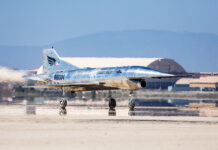Another system unveiled by MBDA Inc is the Tactical Grenade Extended Range (‘TiGER’), a loitering weapon built around a small warhead weighing 1 pound, comprising two 40mm grenades packed in tandem and inserted into a small micro UAV carried in a small tube. TiGER can be used to identify and attack key positions and targets of opportunity, posing an immediate threat to tactical units and special forces teams. With a warhead twice as effective as a standard grenade, TiGER extends the unit lethality to a distance up to two miles, effectively engaging most ypes of threats, including short-lived targets.

The weapon is prepared for use within less than a minute, deploying inflateable wings with compressed air bottle that comes with the kit. The air vehicle is powered by a sall battery, and can fly to a distance of up to two miles, loiter over the target for several minutes and dive onto the target upon operator command. The TiGER can fly to its target through several pre-designated waypoints, providing ‘strike on demand’ opportunities targeting light vehicles, mortar crews or snipers with high effectiveness.
MBDA is proposing TiGER for the U.S. military Lethal Miniature Aerial Munition System (LMAMS) program, pursued by teh U.S. Special Operations Command. LMAMS is designed to provide a soldier carried, ground launched Non-Line-Of-Sight (NLOS) loitering precision guided system organic at the small unit level that will allow unprecedented engagement of enemy combatants without exposing the Warfighter to direct enemy fires.
The Army defined three distinct mission phases for the weapon – mission planning, fly out, and terminal engagement. Once a mission is planned, using geolocation, location reference or direct observation form the operator, field observers or networkes sensors, the GCS will handle the mission autonomously flying the weapon to the area of interest where the weapon enters a loitering mode acquiring the target by visual means. In the terminal engagement phase, the LMAMS will have the ability to automatically track a target designated by the operator in the terminal phase or allow the operator to manually control the system as needed to focus on a specific area or point of interest. The operator shall have the ability to abort and or redirect the flight path prior to impact.




















